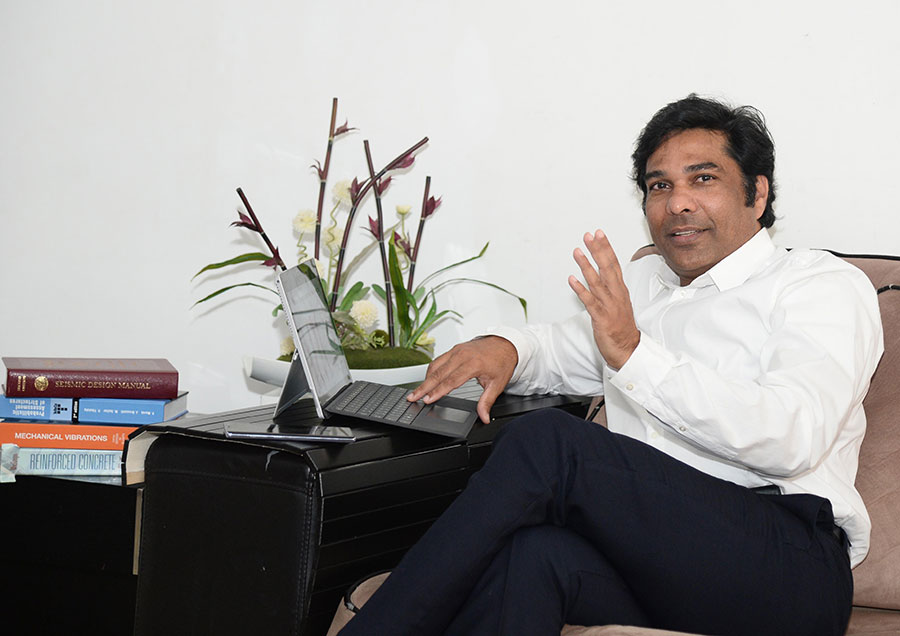An Indian touch behind Smart bridges in Kuwait
IIK Staff Reporter; Photo: Gafoor Moodadi
Thursday, April 22, 2021
Recently Kuwait launched a new first of its kind project in Kuwait entitled “real-time structural health monitoring of highway bridges in Kuwait” a step towards transforming the bridges into "Smart Bridges" across Kuwait! Another step towards the journey to becoming a smart country where the future is leading. In this system the structural condition of the bridges in the country can be assessed remotely in real-time. The system determines the weight of the vehicle, bridge vibration characteristics, deformation, and many other engineering parameters, which will help to find the real-time status of the bridge. This system is a state-of-the-art technology in managing the structural life of bridges, effectively carrying out its maintenance, and assessing the structural safety immediately after an earthquake, etc.
IndiansinKuwait.com is happy to meet the man behind this first of its kind project in this region, Dr Jafarali Parol. Hailing from South India, Kerala, Dr Jafarali is leading this unique research project 'Smart Bridge'. He has carried research activities for the infrastructure development projects across Kuwait to make it 'Smart'.
Working as a Research Scientist in one of the prestigious scientific research institutes in Kuwait, KISR, Jafarali has published many of his research work in the reputed international journals and conferences.
"All buildings and infrastructures deteriorate over time. The deterioration can be accurately assessed, if, some of the important engineering parameters of these structures are monitored continuously. Otherwise, one may not know the exact condition of these structures," Dr Jafarali explained. "on the other hand, if real data are collected from the structures, one can determine the structural condition more accurately and the maintenance can be scheduled more efficiently. This will reduce any unexpected damages to the structure and reduce the unnecessary maintenance cost," he said.
Earthquake causes vibrations in buildings and infrastructures. However, post-earthquake, the uncertainty remains about the structural safety. If a system like this is installed, it can provide accurate data and can determine the structural safety immediately after any earthquake.

" For the first time in the region (probably, first time in the world), we have used a GPS as a sensor to monitor vibrations in the building structure. We have installed GPS in the tallest building in Kuwait and demonstrated that GPS can be effectively used for structural condition monitoring. In 2017, the GPS sensor measured the vibration data in one of the tall buildings in Kuwait due to an earthquake originated from Iran, 640 km away from Kuwait City. This vibration data was vital to determine the structural condition immediately after the earthquake. The data we could collect also helped the entire research community in this region to do further study." Dr Jafarali said.
In this technology, the mathematical algorithms used for the data analysis also play a vital role. AI and machine learning is already creating more opportunities in data driven technology in general and Structural health monitoring in particular. Dr Jafarali and his team at KISR develops sophisticated analysis algorithms to carry out analysis.
In the 'Smart Bridge' project, his team combines the advanced sensors technologies, IoT, and data analytics using Artificial Intelligence. Sensors are installed at critical locations of the bridge and the data are recorded in real time. These measured data by the embedded sensors are used to determine the occurrence of damage, vibrations, vehicle loads, all done in real-time. "Using this, we can accurately predict the structural life of the bridges and carry out a very effective maintenance plan", Dr Jafarali said.
“This technology is just the tip of the iceberg and we expect to see more innovative applications of this technology in the coming years in civil engineering in the future” Dr Jafarali said.
With his keen interest in Research in computational mechanics, coupled with his Civil Engineering background, Dr Jafarali was able to apply some of the sophisticated technologies in the construction scenarios in Kuwait. With a PhD in computational mechanics and his wide experience in R&D institutes in aerospace engineering that he gained from India also helped him in the research work in civil engineering field.
Before joining KISR, Dr Jafarali had worked as a Scientist with India's Aeronautical Development Agency under the Ministry of Defense. He played a crucial role in the structural design of "Tejas" Fighter Aircraft, indigenously developed in India. Dr Jafarali relocated to Kuwait and joined KISR as a Scientist in 2013. Before moving to Kuwait, Dr Jafarali also spent few years with General Electric (GE), one of the pioneer organizations in the US.
In Engineering, whether it is civil engineering or aeronautical engineering, some basic elements are common". A tall building and an aircraft wings can be described using the same mathematical model," Dr Jafarali said. It is necessary to master advanced mathematical concepts in the higher education, that would help young professionals to work in the field of their interest, he advises.
Kuwait is a seismically very low active area. All the buildings in Kuwait are designed to meet the international and national standards. However, adding such technologies and R&D will further enhance the structure's safety and improve efficiency over the period, Dr Jafarali said.
Dr Jafarali is married to Sanaa. They are blessed with two kids Reema Jafar and Reeya Jafar, both are studying in Indian Community School, Amman branch, Kuwait.
s